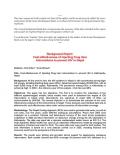Publications - Released in 2007
At this point in time, the HIV epidemic in Nepal is still concentrated among high-risk groups, including injecting drug users (IDUs). Nepal has approximately 20,000 IDUs, with at least 5,000 living in the capital, Kathmandu. HIV prevalence among IDUs in Kathmandu is extremely high. In 2003 – the reference year of this analysis – that rate was 68%.
This paper has two objectives. The first is to examine the robustness of two different epidemiological models; these models were used to determine the impact of IDU interventions in Nepal when interventions are scaled-up to reach 60% of IDUs, as recommended by UNAIDS. The second objective is to disseminate the outcome of two cost- effectiveness analyses of IDU interventions in Nepal. These analyses used identical data sets to determine the cost-effectiveness ratios under various scenarios of intervention coverage.
Nepal has been selected as a case study for two reasons. Firstly, it has good quality cost data information that is easily converted into 2003 prices, and behavioural surveillance data from 2003. Secondly, Nepal was one of four countries in the region where an alpha version of the Asian Effectiveness Model (AEM) (Brown and Peerapatanapokin 2004, Brown T 2005) was available at the time of the analysis (June/July 2007).
Downloads
Organizations
- Asian Development Bank (ADB)
- Joint United Nations Programme on HIV/AIDS (UNAIDS)






